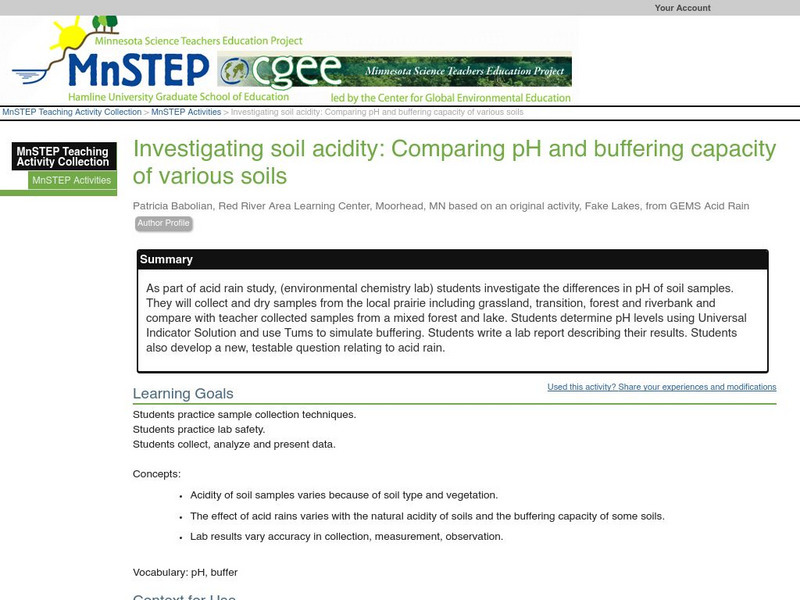Curated OER
GIPSE Lesson Plan
Students participate in a Chemardy game that shows what they recall from the previous year of Chemistry. They use the computer lab and various web sites to explore other areas of chemistry. Students discuss if they think that they...
Curated OER
Electroplating for Corrosion Protection: Redox in Action
Students define what a redox reaction is. In this chemistry lesson plan, students electroplate some wires in the lab. They research the application of electroplating in the real world.
Curated OER
Marine Biology Field Trips
Students visit a Marine Biology study area 2-3 times and write a report after the last visit. They participate in the Marine Biology field trips working with lab partners. They complete data sheets to write their primitive environmental...
Curated OER
Water Hardness- Causes and Testing
Eighth graders examine what materials cause water hardness and the relative measure of water hardness in a two part lab activity. In part one, 8th graders add an assigned soap test solution to eleven different test tube solutions in...
Curated OER
The Importance of Water
Students explore the importance of water. They discuss why water is important and students design an experiment that evaluates the water quality and methods of improving water quality. Students perform testing and report their findings.
Curated OER
Using Thin Layer Chromatography To Identify amino Acids In Solution
Students will work in groups to design and conduct an experiment to identify amino acids found in an unknown solution. This lesson plan is taught in three sections: (1) Introduction to chromatography (2) Experimental design session (3)...
Curated OER
Teaching the Scientific Method Using Adhesives
Students research on the history of adhesives. In this science lesson, students select one test to use in finding the stickiness of adhesives. They collect data and formulate a conclusion.
Kenan Fellows
How Do Chemists Measure?
Young chemists create gold nanoparticles as they learn to measure accurately with the metric system. They create an advertisement for the application of nanotechnology to complete the first lesson in a series of six.
Curated OER
Antacid Lesson Plan
Eleventh graders use titration methods to study properties of antacids. They look at the strength, effectiveness, PH, and effect of supplements taken at the same time. They make observations after the different mixtures are combined and...
Curated OER
How Large is a Mole of M&M's
Students calculate whether or not a mole of M&M's fill their high school. They practice factor-labeling, define a mole, and calculate the number of cubic feet per mole of M&M's. To answer the question they measure and calculate...
Curated OER
Cardiac Arrest! Using Forensics to Investigate Cardiovascular Anatomy and Function
Students identify the different parts and functions of the cardiovascular system. In this forensics lesson, students collect and analyze evidence on a fictional crime. They describe different causes of cardiac arrest.
Curated OER
Dishing the Dirt Part 1
Students create a soil center on their school grounds. They begin to write in their science journals. They participate in an experiment that helps the community begin their own gardens.
Curated OER
Dishing the Dirt Part 2
High schoolers explore the differences between specific soil characteristics. They participate in an experiment in which they discover soil texture. They write their observations in a journal.
Curated OER
Teaching About the Properties of Water
Students use video, Internet research, graphs and tables, worksheets and hands-on experiments to investigate the properties of water in a lake environment. They work under direction or through an inquiry process.
Curated OER
Phosphate Testing Contract
Students examine how to prepare an experimental procedure. In this scientific method lesson plan students conduct an investigation on phosphate.
Curated OER
Natural Inquirer Scientific Process Module
Students investigate the attributes of scientists. In this scientific process lesson, students participate in a classroom activity that requires them to describe the jobs of scientists. Students discuss their findings.
Science Education Resource Center at Carleton College
Serc: Investigating Soil Acidity: Comparing P H and Buffering Capacity of Soils
As part of acid rain study, (environmental chemistry lab) middle schoolers investigate the differences in pH of soil samples. They will collect and dry samples from the local prairie including grassland, transition, forest and riverbank...
Science Education Resource Center at Carleton College
Serc: Determining the Density, P H and Water Content of Various Area Soils
In this chemistry field lab, students will determine the density, pH, and water content of 4 types of soil. Students compare class data and write a lab report describing their results and then analyze their findings to report on the...

















